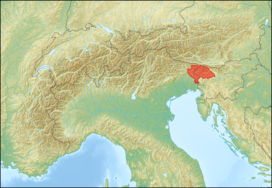Julian Alps
| Julian Alps | |
|---|---|

The Eastern Julian Alps and Mount Triglav
|
|
| Highest point | |
| Peak | Triglav |
| Elevation | 2,864 m (9,396 ft) |
| Coordinates | 46°23′N 13°50′E / 46.383°N 13.833°E |
| Geography | |
|
Julian Alps (in red) within the Alps.
The borders of the range according to Alpine Club classification of the Eastern Alps |
|
| Countries | Italy and Slovenia |
| Range coordinates | 46°20′N 13°45′E / 46.33°N 13.75°ECoordinates: 46°20′N 13°45′E / 46.33°N 13.75°E |
| Parent range | Southern Limestone Alps |
The Julian Alps (Slovene: Julijske Alpe, Italian: Alpi Giulie) are a mountain range of the Southern Limestone Alps that stretch from northeastern Italy to Slovenia, where they rise to 2,864 m at Mount Triglav, the highest peak in Slovenia and of the former Yugoslavia. They are named after Julius Caesar, who founded the municipium of Cividale del Friuli at the foot of the mountains. A large part of the Julian Alps is included in Triglav National Park. The second highest peak of the range, the 2,775 m high Jôf di Montasio, lies in Italy.
The Julian Alps cover an estimated 4,400 km2 (of which 1,542 km2 lies in Italy). They are located between Sava valley and Kanalska Dolina. They are divided into the Eastern and Western Julian Alps.
There are many peaks in the Eastern Julian Alps over 2,000 m high, and they are mainly parts of ridges. The most important peaks are visible by height and massiveness. There are high plains on the eastern border like Pokljuka, Mežakla and Jelovica.
The Main peaks by height are the following:
The Western Julian Alps cover a much smaller area, and are located mainly in Italy. Only the Kanin group lies in part in Slovenia. The main peaks by height are:
Important passes of the Julian Alps are:
The Julian Alps
Edelweiss, Julian Alps, Slovenia
...
Wikipedia

